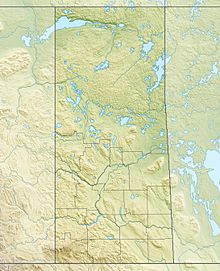Montreal Lake Cree Nation facts for kids
| People | Cree |
|---|---|
| Treaty | Treaty 6 |
| Headquarters | Montreal Lake |
| Province | Saskatchewan |
| Land area | 60.96 km2 (23.54 sq mi) km2 |
| Population (2013) | |
| On reserve | 2,261 |
| Off reserve | 1,417 |
| Total population | 3,678 |
| Government | |
| Chief | Chief Joyce Naytowhow McLeod |
| Council size | 8 |
| Council |
List of Counselors
Joyce Naytowhow McLeod
Dean Henderson Troy Naytowhow Eldon Henderson Carol Naytowhow Rick Bird Charmaine Ermine Elysa Halkett |
| Tribal Council | |
| Prince Albert Grand Council | |
| Website | |
| https://mlcn.ca/ | |
The Montreal Lake Cree Nation (Cree: ᒨᓂᔮᐏ ᓵᑲᐦᐃᑲᓂᕽ, môniyâwi-sâkahikanihk) is a First Nation group. They are part of the Woodland Cree people. This community is located in northern Saskatchewan, Canada. Their main office is in the community of Montreal Lake.
Contents
About the Montreal Lake Cree Nation
The Montreal Lake Cree Nation is a self-governing Indigenous community. They are part of the larger Cree family of First Nations. Their traditional lands are in the northern part of Saskatchewan.
Leadership and Governance
The Montreal Lake Cree Nation is led by a Chief and a Council. These leaders are chosen by the community members. They work to make important decisions for their people. The current Chief is Joyce Naytowhow McLeod. There are also eight counselors who help lead the Nation.
The Montreal Lake Cree Nation is also part of the Prince Albert Grand Council. This is a larger group that helps many First Nations in the area work together.
Treaty Six Agreement
The Montreal Lake Cree Nation is a signatory to Treaty 6. This is an important agreement between the First Nations and the Canadian government. It was signed a long time ago and set out rights and responsibilities for both sides.
Population and Community Life
The Montreal Lake Cree Nation has a growing population. In 2013, there were 3,678 members in total. About 2,261 people lived on their reserve lands. The rest lived in other places.
Population Growth Over Time
The community has seen its population grow steadily.
- In 2006, the population living on the reserve was 880 people.
- By 2011, this number grew to 999 people.
- In 2016, the population reached 1,113 people.
This shows that more and more people are choosing to live in their home community. The average age of people in the community is quite young, around 23 years old. This means there are many young people and families living there.


